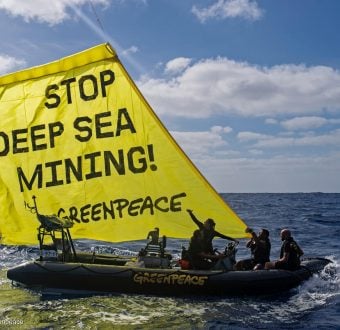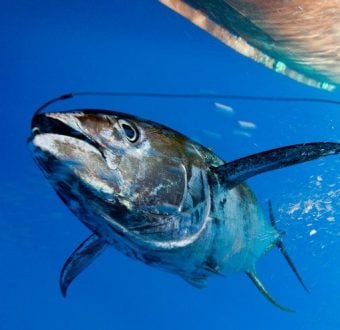Washington, DC – Over the past year, Greenpeace collected microplastic data as part of 5 Gyres’ TrawlShare program while its ship the Arctic Sunrise traveled down the East and West Coasts. The TrawlShare program engages partners and community scientists globally to collect data on ocean plastics, which will contribute to an update of 5 Gyres’ 2014 global estimate. Utilizing a manta trawl net, the organization sampled 13 locations along the East Coast, 17 locations on the West Coast, and six locations on its Atlantic crossing from Amsterdam to New York City. Varying quantities of microplastics were found in every single sample collected, whether in the middle of the ocean or closer to shore.
Greenpeace will travel to the North Pacific Gyre, which has become known as the Great Pacific Garbage Patch, in late September to continue its microplastic data collection. The organization will document the quantity and types of microplastics present, work to identify the sectors or corporations responsible for the plastic pollution, and capture extensive photo and video footage of the gyre. Greenpeace is working to dispel the notion that we can simply clean up the plastics in the ocean, instead calling on corporations to reduce their single-use plastic footprints.
“We have found microplastics on the East Coast, the West Coast, and in the middle of the ocean,” said Greenpeace Plastics Campaigner Kate Melges. “We traveled to Antarctic waters, and found plastics there. Researchers have even found plastics in the deepest point of the ocean, the Mariana Trench. No matter how far we are from land, we are seeing the impact of corporations’ addiction to plastics. It’s time for businesses and governments to phase out single-use plastics for good.”
Between its East and West coast ship tours, Greenpeace also traveled to the Antarctic and conducted microplastic samples in the region using 5 Gyres’ trawling net. Microplastics and microfibers were even found in the remote Antarctic waters. Greenpeace was conducting scientific research, including landmark submarine dives to little-known Antarctic seabed ecosystems, as part of a campaign to create an Antarctic Ocean Sanctuary.
On the East Coast in late 2017, Greenpeace collected microplastics data along the Hudson River and New York Harbor in NY, at the Elizabeth River in Norfolk, VA and off the coast of Wilmington, NC and Miami, FL. On the West Coast in 2018, Greenpeace collected microplastics in the Pacific Ocean near Port Angeles, WA, Portland, OR, San Francisco, CA, Long Beach, CA, and San Diego, CA. The organization also conducted sampling further out to sea on its transits between the ports. Greenpeace found the highest concentrations of microplastics near Brooklyn on the East Coast and near Long Beach on the West Coast. Higher quantities of microplastics were found in samples collected closer to land.
“Our TrawlShare program was designed to grow our global microplastics dataset that is now focusing on areas closer to land,” said Carolynn Box, 5 Gyres Science Programs Director. “It was clear that we needed more data in bays and near shore environments to use as evidence to support policies limiting single-use plastics and requiring better product design. Greenpeace has collected an impressive number of microplastic samples that support the growing trend that microplastics are everywhere – a plastic smog in the world’s oceans.”
As part of its TrawlShare program, 5 Gyres provides trawls and protocols for community scientists to collect data on marine plastic pollution, raise awareness about this important issue, and contribute to a more robust global dataset. In 2014, 5 Gyres published the first global estimate on plastic pollution in the world’s oceans. The data from Greenpeace and other community scientists will be used to update the Global Estimate of Marine Plastic Pollution, planned for release in early 2019.
A table of the Greenpeace microplastics data is available upon request.
For photos of Greenpeace’s microplastic data colletion, please see: https://media.greenpeace.org/
###
Contact: Perry Wheeler, Greenpeace Senior Communications Specialist, P: 301-675-8766


